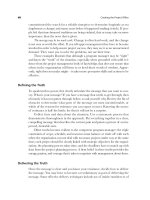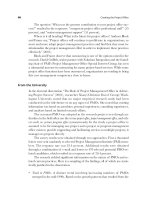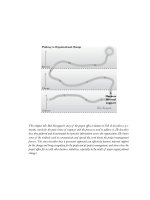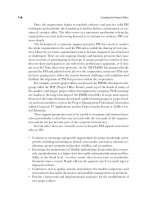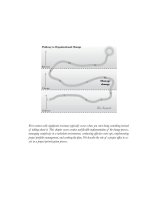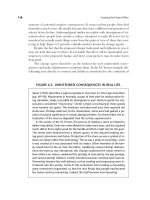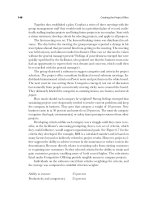Creating the project office 13
Bạn đang xem bản rút gọn của tài liệu. Xem và tải ngay bản đầy đủ của tài liệu tại đây (74.01 KB, 10 trang )
The question “What was the greatest contribution to your project office suc-
cess?” resulted in the responses: “competent project office professional staff ” (55
percent), and “senior management support” (51 percent).
Where is it all heading? What is the future for project offices? Authors Block
and Frame say, “Project offices will continue to proliferate in organizations, as
more and more adopt project management practices and find that they must in-
stitutionalize the project management effort in order to implement these practices
effectively” (2001).
Block and Frame observe that outsourcing is one of the options raised in the
research. David Griffith, senior partner with Solutions Integration and the found-
ing chair of PMI’s Project Management Office Special Interest Group, has seen
a substantial increase in outsourcing for many project-based services. While some
project office functions have been outsourced, organizations are tending to bring
this core management competency close to home.
From the University
In the doctoral dissertation “The Role of Project Management Office in Achiev-
ing Project Success” (2001), researcher Xiaoyi Christine Dai of George Wash-
ington University stated that no major empirical research study had been
conducted on the title theme or on any aspect of PMOs. She noted that existing
information was based on anecdotes, personal experiences, consulting experiences,
and analyses based on limited research efforts.
The acronym PMO was adopted in the research project even though au-
thorities in the field often use the terms project office, project management office, and oth-
ers such as systems program office synonymously. In the study a project office is
assumed to be for managing one project and a project or program management
office exists to provide supporting and facilitating services to multiple projects; it
manages no projects directly.
The survey results were obtained through two approaches. First a thousand
letters were sent randomly to selected Project Management Institute (PMI) mem-
bers. The response rate was 23.4 percent. Additional results were obtained
through a combination of e-mail and letters to 470 selected potential PMO-re-
lated candidates, which resulted in a response rate of 20.4 percent.
The research yielded significant information on the nature of PMOs and re-
lated current practices. Here is a sampling of the findings, all of which are statis-
tically justified in the dissertation.
• Trend in PMOs. A distinct trend involving increasing numbers of PMOs
emerged in the mid-1990s. Based on the growth patterns that resulted from the
98 Creating the Project Office
survey, the author concluded that PMOs will continue to increase in number
at least for the next several years.
• Management level for PMO establishment approval. In the survey, an overwhelming
proportion of PMO establishments were approved at an upper management
level (85 percent). This supports the theory that upper management is at least
somewhat involved and interested in their respective organizations’ approach
to project management and particularly in the PMO approach.
• Frequency of full-time staffing for an organization’s PMO. In over 90 percent of the
cases studied, full-time staffing of a PMO was the preferred model. The re-
search did not yield accurate information on ranges and averages of staffing.
It is likely that such numbers will depend on the nature and variety of the roles
assigned to a PMO and its position within an organization.
• Major functions and services of PMOs. Although the range of services indicated by
the respondents was broad, the findings can be summarized as follows:
All ninety-six PMO respondents from the targeted sample reported a major
function as performing “PM standards and methods.”
The next most frequently reported item was “consulting and mentoring.”
The following functions were also mentioned frequently, though at lesser lev-
els: providing administrative support, providing and arranging PM train-
ing, and maintaining historical archives.
• Survey conclusion. The survey concluded that additional research is required to
yield conclusive evidence regarding the effectiveness of the PMO concept, yet
the author allowed that the research hypothesis, that the PMO presence index
has a linear influence on reported project success, “could be largely accepted.”
Project Offices: Some Real-Life Cases
A few cases that illustrate the wide range of POs are shown in this chapter (other
detailed cases are woven throughout the book). Settings for the POs featured here
include a multinational telecommunications company, a U.S. government-
sponsored research program, and a major IT manufacturer and service company.
Part of a Global Organization—Ericsson Australia
The project office effort in Ericsson Australia started in 1997 with the establish-
ment of the Center of Excellence, which lasted about twelve months and had a
staff of one. Shortly thereafter, a formal project office was located in the major
business unit, Australian Services, yet the PO maintained cross-organization
responsibility.
Focus 99
For the first year, the PO aimed primarily at increasing the competency level
of project management. That increased competence was designed to influence
project performance, which in turn was to increase the probability of successful
project completion. At that point the PO was acting primarily as a project sup-
port office or PSO. The roles and responsibilities for the project office in this stage
of the Ericsson development include
• Owning the PM process
• Setting standards and benchmarks
• Developing PM competence
• Owning the profession
• Achieving certification
• Justifying position in organization
Thereafter, the PO was tasked with organizational responsibilities, including
reporting on the project portfolio so the executive team could receive the infor-
mation necessary to manage the project organization. This process included the
meetings and structure to report and provide opportunity for intervention and es-
calation. This meant that the PO was beginning to act as an organization support
project office, where the scope of work transcends project management processes
and methodologies. The role includes active interfacing with the rest of the or-
ganization and an emphasis on the management of multiple projects. The roles
and responsibilities of an organization support PO include everything listed for
project support office, plus
• Drive adherence to process through reviews and other measures
• Establish management of projects
• Performance manage the project managers
• Manage forecast load
• Serve as capability owner for project management
• Continue to justify position in organization
The organization support PO therefore covers both project management
competence and organization competence. This PO is designed to boost not only
project competence and performance but organization competence and perfor-
mance as well.
In mid-2001, during a reorganization, the project office staff proposed the
adoption of a “business delivery model,” with project office project managers shar-
ing responsibility for business-related results, including an agreed margin. The
100 Creating the Project Office
roles and responsibilities of a business delivery PO include everything listed for
project management support office, plus
• Support presales activities
• Be accountable for estimating process
• Manage order desk and end-to-end delivery process
• Provide business support, such as risk analysis for technical, commercial, and
project definitions
• Drive project management performance
• Be accountable for delivering the agreed margin
The organization changes caused by the transition from manufacturing-based
company to global supply chain resulted in a dramatic increase in the percentage
of income directly generated by projects. Throughout the implementation of the
project office concept, upper management was supportive and helped maintain
the momentum. During 2001, with the slowdown in the telecommunications in-
dustry, major downsizing took place and this slowed the implementation of the
business model PO, which is still under way at this writing.
Challenges faced in implementing and operating the project office concept
stemmed in part from two other business units, Marketing & Sales and Services,
which were responsible for delivering the contracted requirements. Establishment
of the PO and associated processes made project performance more visible to the
organization as a whole. Consequently, considerable friction appeared between
various sectors of the organization.
Is Ericsson in Australia a more productive company due to implementation
of project offices? According to Chris Cartwright, project management compe-
tence manager of Ericsson Australia’s project office, “This is almost impossible to
measure with all the major changes internally and externally within the industry
and the company. What it has done is to raise the whole issue of project perfor-
mance and provided the framework to manage this.” He also notes that the in-
creasingly project-based culture at Ericsson is reflected in the monthly leadership
forums, where the CEO opens the session with traditional financial results and
immediately thereafter presents project performance results.
A Pioneering PMO
In 1977, the Pacific Northwest Laboratory (PNL), which is operated for the U.S.
Department of Energy by Battelle Memorial Institute in Richland, Washington,
embarked on a program to improve project performance. The projects were
Focus 101
largely aimed at developing new energy sources, improving existing energy
sources, and examining methods for containing and disposing of nuclear waste
generated from power reactors. To improve project performance, the lab decided
to use a centralized approach to manage research projects that ran the gamut from
early stages of research to beginning stages of development. Lee R. Lambert, now
a consultant, was hired to lead the project management enhancement program.
An initial question generated discussion among principal stakeholders: should
the project management office be structured as a control function with its costs
allocated to organization overhead, or should it be perceived as a value-added
function and be obliged to pay its own way. The charge-to-overhead approach
would constitute a service tax assessed to all projects, whether the project man-
agers wanted the service or not. Under the second premise, the PMO would pro-
vide recognized value, and R&D scientists would be willing to pay for the service
from their research budgets. The value-added philosophy assumed that once the
value of the support was demonstrated, every project manager would want to take
advantage of the project management support. They selected the value-added
alternative.
Process structure, procedures, discipline, and consistency in approach to man-
aging PNL’s projects were initially lacking, and these project management com-
petencies would be a part of the new organization’s charter. But, because the fear
of being controlled (interpreted as stifling creativity by the scientists) in an R&D
environment was substantial, PNL chose a nonthreatening name for this new or-
ganization: Management Information and Support (MIS).
The consistently demonstrated success of the service was almost immediate,
according to Lambert; projects that used it got better results, were faster and more
cost effective, and had better communications, and research project managers
quickly grasped the potential return on their investment for using the concept.
The feedback cited better work definition, more realistic schedules, much more
effective use of resources among multiple projects, and ability to separate the truly
important issues from the unimportant—all leading to timely and informed deci-
sions and satisfied customers.
The demand for project support exceeded the supply of qualified project
management staff available in MIS. Recruiting became aggressive. The focus was
internal as the MIS group sought to enlist staff from the technical disciplines to
which they would eventually be providing project management support. Many of
PNL’s qualified technical people opted to change career paths to join this new ser-
vice group. In about three years the organization grew from one to nineteen peo-
ple—all fully funded by the research projects they supported.
Several factors were key to achieving successful implementation of the PMO
philosophy. First, it was handled using the principles of project management, with
102 Creating the Project Office
